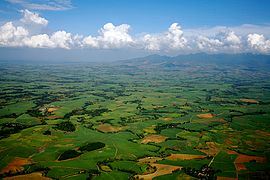
Economy of the Philippines
The economy of the Philippines is an emerging market, and considered as a newly industrialized country in the Asia-Pacific region.[31] In 2024, the Philippine economy is estimated to be at ₱26.55 trillion ($471.5 billion), making it the world's 32nd largest by nominal GDP and 13th largest in Asia according to the International Monetary Fund.
Currency
Philippine peso (Filipino: piso; sign: ₱; code: PHP)
Calendar year
- Agriculture: 8.6%
- Industry: 29.1%
- Services: 62.3%
- (2023)[7]
- Household consumption: 73.1%
- Government consumption: 14.2%
- Gross capital formation: 23.1%
- Exports of goods and services: 27.4%
- Imports of goods and services: -39.2%
- Other source: 10.6%
- (2023)[7]
![]() 3.9% (May 2024)[8]
3.9% (May 2024)[8]
![]() 41.2 medium (2021)[11]
41.2 medium (2021)[11]
![]() 34 out of 100 points (2023, 115th rank)
34 out of 100 points (2023, 115th rank)
 48.36 million
48.36 million 64.1% participation rate
64.1% participation rate- (April 2024 est.)[13]
- Agriculture: 20.3%
- Industry: 18.3%
- Services: 61.4%
- (April 2024 est.)[13]
 4.0%
4.0% 2.04 million unemployed
2.04 million unemployed- (April 2024 est.)[13]
₱18,423 / US$338 monthly (2022)[14]
![]() ₱4.90 trillion (2022)[15]
₱4.90 trillion (2022)[15]
- Electronic products 56.9%
- Agricultural products 8.7%
- Manufactured goods 5.4%
- Mineral products 4.2%
- Ignition wirings 3.6%
- Machinery and Transport equipments 3.3%
- Other 17.9% (2023)[19][20]
 United States 15.7%
United States 15.7% ASEAN 15.2%
ASEAN 15.2% China 14.8%
China 14.8% Japan 14.2%
Japan 14.2% Hong Kong 12.0%
Hong Kong 12.0% European Union 11.4%
European Union 11.4%- Other 16.7% (2023)[20]
- Electronic products 21.1%
- Mineral fuels 15.9%
- Agricultural products 14.2%
- Transport equipments 9.9%
- Iron and steel 4.5%
- Industrial machinery 4.4%
- Other 30.0% (2023)[19][20]
 ASEAN 29.9%
ASEAN 29.9% China 23.3%
China 23.3% Japan 8.2%
Japan 8.2% South Korea 6.7%
South Korea 6.7% United States 6.7%
United States 6.7% European Union 6.2%
European Union 6.2%- Other 19.0% (2023)[20]
 $125.394 billion
$125.394 billion 28.7% of GDP (2023p)[7]
28.7% of GDP (2023p)[7]
- -₱1.512 trillion
- (-$27.21 billion)
- −6.2% of GDP (2023)[7]
- ₱3.824 trillion
- ($68.81 billion)
- 15.7% of GDP (2023)[7]
- ₱5.336 trillion
- ($99.63 billion)
- 22.0% of GDP (2023)[7]
recipient: $1.67 billion (2011)[25]
- Japan Credit Rating Agency:[26]
- A− (Domestic/Foreign)
- A− (Bonds)
- Outlook: Stable
- Standard & Poor's:[27]
- BBB+ (Domestic/Foreign)
- BBB+ (T&C Assessment)
- Outlook: Stable
The Philippine economy is transitioning from one based on agriculture to one based more on services and manufacturing. It has experienced significant economic growth and transformation in recent years. With an average annual growth rate of around 6 percent since 2010, the country has emerged as one of the fastest-growing economies in the world.[32] The Philippines is a founding member of the United Nations, Association of Southeast Asian Nations, Asia-Pacific Economic Cooperation, East Asia Summit and the World Trade Organization.[33] The Asian Development Bank (ADB) is headquartered in the Ortigas Center located in the city of Mandaluyong, Metro Manila.
The country's primary exports include semiconductors and electronic products, transport equipments, garments, chemical products, copper, nickel, abaca, coconut oil, and fruits. Its major trading partners include Japan, China, the United States, Singapore, South Korea, the Netherlands, Hong Kong, Germany, Taiwan, and Thailand.
In 2017, the Philippine economy was projected to become the 9th largest in Asia and 19th largest in the world by 2050.[34] By 2035, the Filipino economy is predicted to be the 22nd largest in the world.[35]
The Philippines has been named as one of the Tiger Cub Economies, alongside Indonesia, Malaysia, Vietnam, and Thailand. However, major problems remain, mainly related to alleviating the wide income and growth disparities between the country's different regions and socioeconomic classes, reducing corruption, and investing in the infrastructure necessary to ensure future growth.
In 2024, the World Economic Forum chief Børge Brende said that “there is a real opportunity for this country to become a $2-trillion economy.”[36]
GDP-related data can be found here:




